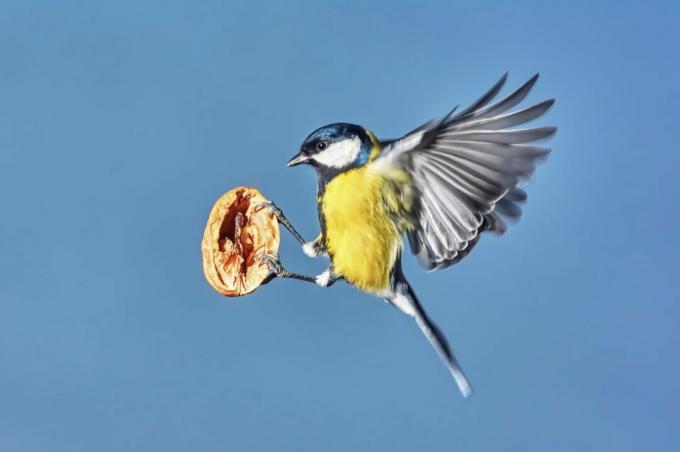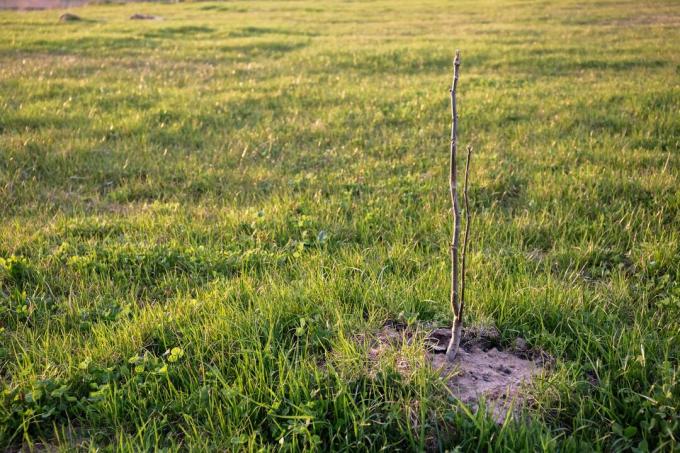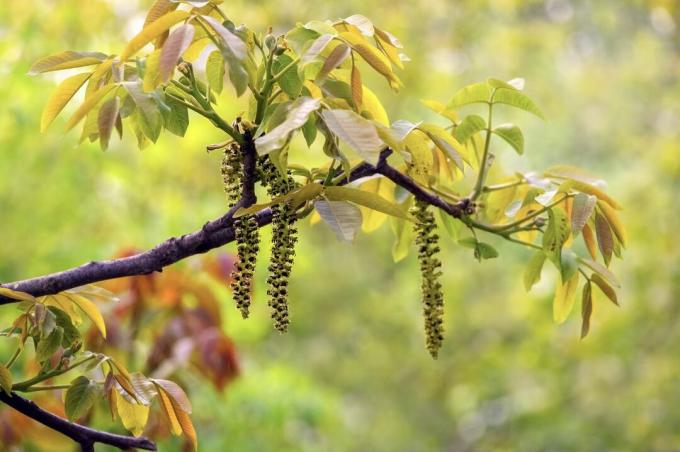The walnut tree is especially popular with many people for its delicious fruit. You can find the most important facts about the walnut tree here.

With its stately size and the very robust and undemanding nature, the walnut tree is a very impressive tree. With enough space, a warm location and a little patience, it can be an asset to orchards or gardens.
contents
- Walnut tree: profile and origin
- The most popular varieties of walnut trees
- Plant walnut tree
-
Care of the walnut tree: cutting, fertilizing and Co.
- Cut walnut tree
- Fertilize and water walnut tree
- Propagation of the walnut tree
- Chop down the walnut tree
- Harvest and use walnuts
- Pests and diseases on the walnut tree
- Are parts of the walnut tree poisonous?
Walnut tree: profile and origin
The historic home of the walnut tree (Juglans regia) is in ancient Rome. In the meantime, the “divine fruit of Jupiter” is widespread not only in the warm Mediterranean region, but throughout Europe. Their love of warmth has been weakened by breeding, so that there are now private and commercial walnut tree plantations in this country as well. The walnut tree belongs to the walnut family (Juglandaceae) and is best known for the popular walnut.
The walnut tree leaves are pinnate unpaired and consist of 7-9 leaves. The male walnut tree blossoms have a special shape with their long, serpentine inflorescences. With enough space it can be a great enrichment for animals and humans. If there is little space, planting a walnut tree in the garden may be forbidden because it will be very large and wide. On the other hand, large and old walnut trees are protected and cannot be felled without permission. This is especially true for urban areas. The reason: Anyone who researches which animals live in the walnut tree reveals a considerably long list. Squirrels, dormice, protected corvids, rodents and various insects benefit from a walnut tree in the garden.

The most popular varieties of walnut trees
There are different varieties of walnut trees: They differ in terms of their growth, their resistance, the time of ripening, the fruit properties and the time of sprouting.
The walnut varieties ‘Mars’ (Juglans regia 'Mars') or 'Franquette' (Juglans regia ‘Franquette’) are particularly resistant and, due to their late budding, not very sensitive to late frosts. In the case of grafted plants, yield can be expected in regularly high quantities as early as the third or fourth year. The ‘Franquette’ is a rather slow-growing variety. Another new variety with a good yield is the ‘Buccaneer’, which also sprouts late. Other varieties that sprout late and are therefore also suitable for cold locations are the ‘Geisenheim walnut’ or the ‘Weinheim walnut’. The Jupiter ’or‘ Esterhazy II ’varieties are more suitable for warmer locations due to their early budding.
For smaller gardens there are various types of dwarf walnut, such as the ‘Europa’, which are only around 3 to 4 meters tall.

Plant walnut tree
The ideal location for a walnut tree is warm and sunny, with lots of light. In addition, the walnut tree needs enough space and clearance as it can develop a very large crown. In doing so, a distance of at least 5 to 10 meters to the neighboring property should be kept - you have this space not, the planting of a large walnut tree in the garden is forbidden, at least according to the rules of border planting in the Neighborhood law. Very little grows in the places where the leaves and pods of the walnut tree fall. This is due to the active ingredients contained, which can be converted by microorganisms into the tannin juglone. This can inhibit the growth of other plants.

The soil should be deep, well-ventilated and rich in nutrients. The planting hole for the walnut tree should be at least 1.5 times as wide and deep as the walnut tree roots in the ball. The planting hole can then be filled with mature compost or high-quality potting soil like ours Plantura organic universal soil filled and mixed with the excavation. Our universal soil is ideal for outdoors, as it is harmless to all garden animals and enhances both heavy and light soils.
You can then tie the tree with one or two stakes, depending on its size. Last but not least, the ground around the trunk is tread well and the tree is poured with water.
The ideal time to plant a walnut tree is in spring or autumn. This should preferably be done after or before frosts occur, as the young plants are still very sensitive to frost. If you plant your walnut tree in autumn, it has the advantage that it can still develop fine roots that are helpful for water absorption in spring and summer.
The height of the walnut tree can be 15 to 25 meters in age.
Care of the walnut tree: cutting, fertilizing and Co.
Walnut tree care is not difficult at all if a few important points in the areas of cutting, fertilizing and watering are observed.
Cut walnut tree
As a rule, walnut trees only need to be pruned a little. If the crown and branches become very expansive, a maintenance pruning may be necessary to maintain the shape of the walnut tree and to contain the spreading somewhat. For this purpose, only competing branches that grow in the same direction or that steal light or space should be shortened. Cut this at the front branch so as not to create too many intersections. The walnut tree can often "bleed again" at the interfaces, which is why a pruning between the end of June and the end of September is recommended. The incision should not result in a horizontal surface so that there is no water on the wound. Walnut trees are cut on astring, so no "stub" should be left. A rejuvenation cut in old trees is only possible to a limited extent due to the large, resulting wounds.

Fertilize and water walnut tree
If it is dry it may be necessary to water your walnut tree. Especially with young plants that do not yet have a pronounced root system, sufficient water is important for development in the first few months. The tree should not be watered as often, but rather heavily.
Walnut trees are very undemanding, they have comparatively low nutrient requirements and little phosphorus. A needs-based supply is, for example, with our Plantura organic flower fertilizer possible, which contains a relatively large amount of potassium and nitrogen, but comparatively little phosphorus. Because most of these nutrients are in organic form, fertilization is slow and gentle. Alternatively, compost can be used, but not too fresh rotting material should be used - this is often much too rich in nutrients. A good time to fertilize the walnut tree is after the fruit has fallen.

Tip: Annual maintenance should also include removing and disposing of the leaves and old fruit peels. Because it is from these that diseases can spread again in the coming spring.
Propagation of the walnut tree
Walnut trees can be re-grown via the nut. For this purpose, it should be as fresh as possible and can either be placed directly in the soil in its future place in the bowl or used in the pot. In the open air you often have problems with mice, which makes growing them in pots more promising. You should set it up in a cold, but frost-free place such as the balcony or a shed, as it is one Cold germ acts. In spring, when the first shoot can be seen, plant the walnut again in a new pot with soil. When the late frosts are over, the seedling can be put in its designated place and should be watered regularly.

It is also possible to buy plants that have already been grafted in specialist shops. The yields here are often safer and more predictable because the properties of the plants used are known. Grafted walnut trees can also bear fruit in the fourth or fifth year, whereas seedlings only produce the first fruits after 10 years or more.
Another possibility is the propagation of non-grafted walnut trees by means of piling. To do this, a young plant should be cut off about a hand's breadth above the ground and earth "piled up" over the stump. In the best case, many new small shoots will form. If these are rooted, they can be cut off or torn off and replanted in the ground.
When choosing a location, it is also important to know that non-grafted seedlings often grow later in width and grafted walnut trees grow taller.
Tip: Independent walnut tree finishing is also possible, but a bit more demanding and only succeeds with a little background knowledge and appropriate technical equipment.

Chop down the walnut tree
If you want to fell your walnut tree, you should find out about the applicable regulations in advance from your municipality. In most regions it is forbidden to fell walnut trees without a permit, depending on the size of the trunk. In addition, according to the Federal Nature Conservation Act, tree felling on private land is between 1. March and 30. September not allowed. If this permit has been granted and you have little experience in felling large trees, it is best to get a professional to do the job.
Harvest and use walnuts
Harvest time for the walnut tree is around September. When the fruit is ripe, the green peel comes off and the familiar brown walnut emerges. This is very brown in color, which is why gloves and insensitive clothing are best suited for collecting.

Due to its many nutrients, the walnut is a real superfood. It contains a relatively large amount of zinc, potassium, calcium, vitamin C and nutritionally valuable unsaturated fatty acids. It can be used for direct consumption, for baking or as a fine flavor supplement when cooking. Walnut ice cream is also finding more and more friends. The nuts are also eaten with pleasure, especially at Christmas time.
Pests and diseases on the walnut tree
A common pest on the walnut tree is the walnut fruit fly, which was discovered relatively recently in Europe (Rhagoletis completa). This sticks into the green shell to lay eggs. The maggots then eat the pulp, which turns a distinctly black color. The nut itself remains intact except for a few black spots on the shell.
A disease that occurs frequently in the walnut tree is leaf spot disease, which occurs shortly after flowering, especially in very damp weather. This can be caused by various bacterial or fungal pathogens. A severe infestation can mean that the nuts are no longer edible and that the tree sheds all of its leaves before the fruits are ripe. Some varieties such as ‘Sheinovo’ or ‘Reinuss Kläusler’ have resistance or increased tolerance to some leaf spot diseases.

Are parts of the walnut tree poisonous?
Parts of the walnut tree can be toxic to animals such as horses.
Parts of plants such as leaves are also harmless to humans, but in sensitive people these or the green peels can lead to gastrointestinal problems or severe vomiting.
The walnut is considered a superfood - one of the reasons for this is its high zinc content. You can find more in our special article Fruits and vegetables high in zinc.



